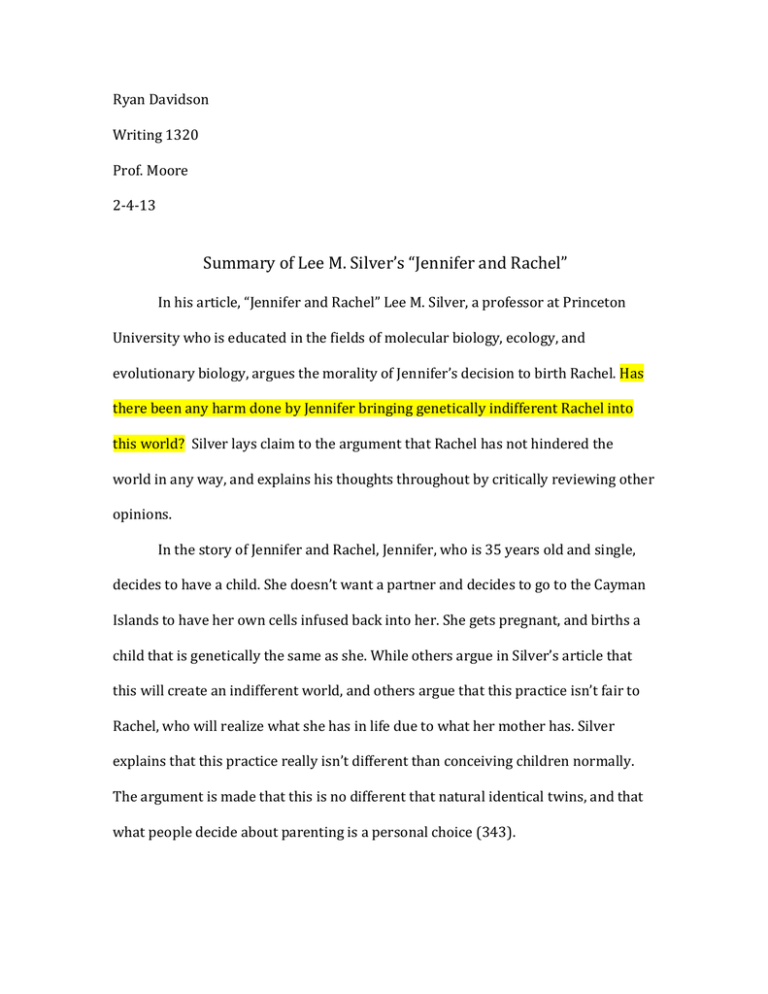RdavidsonSummaryFINAL
advertisement

Ryan Davidson Writing 1320 Prof. Moore 2-4-13 Summary of Lee M. Silver’s “Jennifer and Rachel” In his article, “Jennifer and Rachel” Lee M. Silver, a professor at Princeton University who is educated in the fields of molecular biology, ecology, and evolutionary biology, argues the morality of Jennifer’s decision to birth Rachel. Has there been any harm done by Jennifer bringing genetically indifferent Rachel into this world? Silver lays claim to the argument that Rachel has not hindered the world in any way, and explains his thoughts throughout by critically reviewing other opinions. In the story of Jennifer and Rachel, Jennifer, who is 35 years old and single, decides to have a child. She doesn’t want a partner and decides to go to the Cayman Islands to have her own cells infused back into her. She gets pregnant, and births a child that is genetically the same as she. While others argue in Silver’s article that this will create an indifferent world, and others argue that this practice isn’t fair to Rachel, who will realize what she has in life due to what her mother has. Silver explains that this practice really isn’t different than conceiving children normally. The argument is made that this is no different that natural identical twins, and that what people decide about parenting is a personal choice (343). Davidson, 2 Silver argues that although Rachel’s genetic makeup is the same, it doesn’t mean she will live the same life as her mother. They will make different decisions, and on top of that, they are growing up in two different times, Rachel will not have the same problems, or benefits her mother had as a child. Silver believes there is absolutely no reason that Rachel can’t chart her own path through her life. Dr. Callahan goes on to argue that Rachel’s upbringing would come with unrealistic expectations of her (342). Silver counters these thoughts. He doesn’t see the rationale behind this thinking that Jennifer will place these unrealistic expectations on her. Silver says she can be a loving and nurturing mother, just like everyone else. Many points are brought up here, to help support his argument. Silver concedes the fact that some people will always feel bad for the many people like Rachel in this world, what he doesn’t give up is the that cloning and identical twins are the same. Silver wants readers to think about the differences between Rachel, and an older twin. If that older twin was going through tough times, and the younger realizes they to will have to endure them as well, is there any difference in that and the case of Rachel? Silver doesn’t give an answer to this; it is strictly to open up a new thought process. Lee M. Silver also includes a response from Mr. Safire, a columnist for the New York Times, who believes that bringing Rachel’s into this world will hurt it negatively. Safire argues it will take away the ability to evolve as people because of the prospect of having more identical twins (344). Silver doesn’t agree with this theory, arguing that no matter what, even if this practice became legal, it will still Davidson, 3 only account for a very small percentage of all pregnancies. And he argues; that these children will still be coming from different families, making all children still have different genes. Silver doesn’t understand how this makes the world identical, because family-to-family is still very different. Also, a statement about how evolution is always different, and not always upward bound is including, furthermore showing how Silver feels. One last example is given, about Dolly the Sheep. Dolly was the very first clone to happen. Politicians to preachers expressed outrage about this and thought it should be banned once and for all. Silver seems to take sides with the lone political supporter, a senator from Iowa. The senator believes that cloning was made available for a reason, and that since the technology is here, it might as well be made useful. The senator doesn’t feel, or see the harm in cloning, and it seems Silver agrees one hundred percent (342). Lee M. Silver is not out to get anyone. He won’t jump on your back and demand you are wrong. He is simply a man who has expressed his thoughts on a subject. Silver suggests many times throughout his article that now cloning is available, there is little or nothing a government can do about it. If one door closes, another will surely open somewhere else. Silver realizes that this subject will be brought up again, but there is just nothing, it seems, that one government can do about it. Works Cited Silver, Lee M. “Jennifer and Rachel.” Writing in the Disciplines: A Reader and Rhetoric for Academic Writers. 6th ed. Eds. Mary Lynch Kennedy and William J. Kennedy. Upper Saddle River: Pearson, 2008. 340-46. Print.




